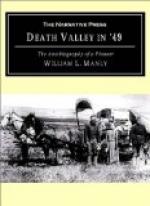We made a pine box, and putting his body in it, laid it away with respect. I had often heard him say that if he suffered an accident, he wished to be killed outright and not be left a cripple, and his wish came true.
After this accident the blacksmith working for the Paradise Co., was making some repairs about the surface of the air shaft, and among his tools was a bar of steel an inch square, and 8 or 10 feet long, which was thrown across the shaft, and while working at the whim wheel he slipped and struck this bar which fell to the bottom of the shaft, 100 feet deep and the blacksmith followed. When the other workmen went down to his assistance they found that the bar of steel had stuck upright in the bottom of the shaft, and when the man came down it pierced his body from hip to neck, killing him instantly. He was a young man, and I have forgotten his name.
Those who came to California these later years will not many of them see the old apparatus and appliances which were used in saving the gold in those primitive days. Among them was the old “Rocker.” This had a bottom about 5 feet long and 16 inches wide, with the sides about 8 inches high for half the length, and then sloped off to two inches at the end. There was a bar about an inch high across the end to serve as a riffle, and on the higher end of this box is a stationary box 14 inches square, with sides 4 inches high and having a sheet iron bottom perforated with half inch holes. On the bottom of the box are fastened two rockers like those on the baby cradle, and the whole had a piece of board or other solid foundation to stand on, the whole being set at an angle to allow the gravel to work off at the lower end with the water. A cleat was fastened across the bottom to catch the gold, and this was frequently examined to see how the work was paying, and taking out such coarse pieces as could be readily seen. To work the rocker a pan of dirt would be placed in the square screen box, and then with one hand the miner would rock the cradle while he poured water with the other from a dipper to wash the earth. After he had poured on enough water and shaken the box sufficiently to pass all the small stuff through he would stir over what remained in the screen box, examining carefully for a nugget too large to pass through the half inch holes. If the miner found that the dirt did not pay he took his rocker on his back and went on in search of a better claim.
Another way to work the dirt was to get a small head of water running in a ditch, and then run the water and gravel through a series of boxes a foot square and twelve feet long, using from one to ten boxes as circumstances seemed to indicate. At the lower end of these boxes was placed the “Long Tom” which was about two feet wide at the lower end, and having sides six inches high at the same point. The side pieces extend out about 3 feet longer than the wooden bottom, and are turned up to a point, some like a sled runner, and this turned up part has a bottom of sheet iron punched full of holes, the size of the sheet iron being about 3 feet by 16 inches.




